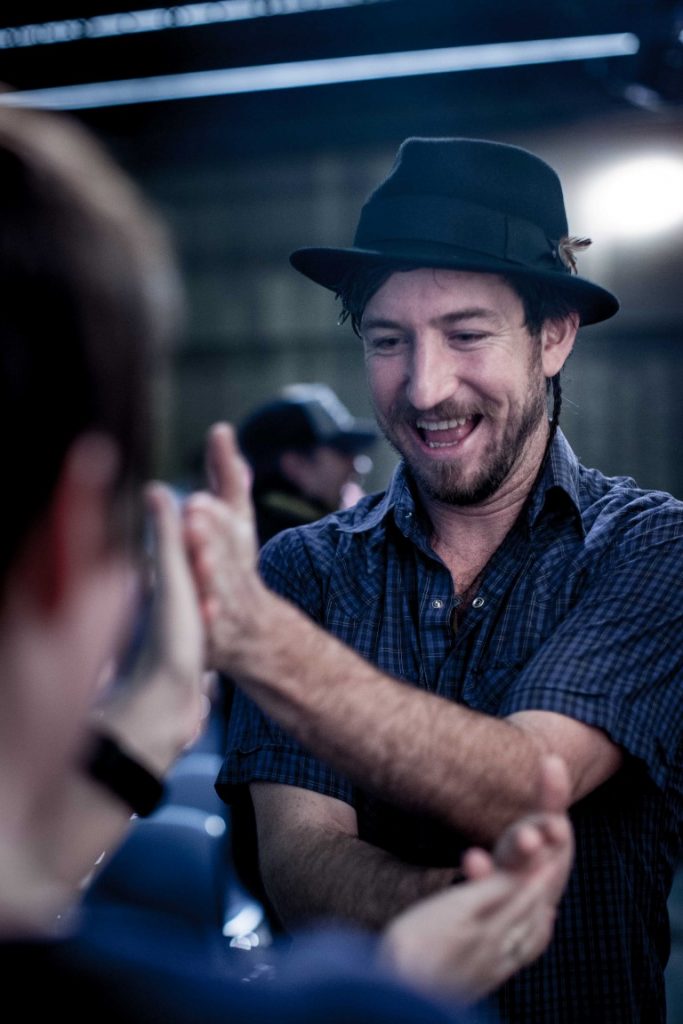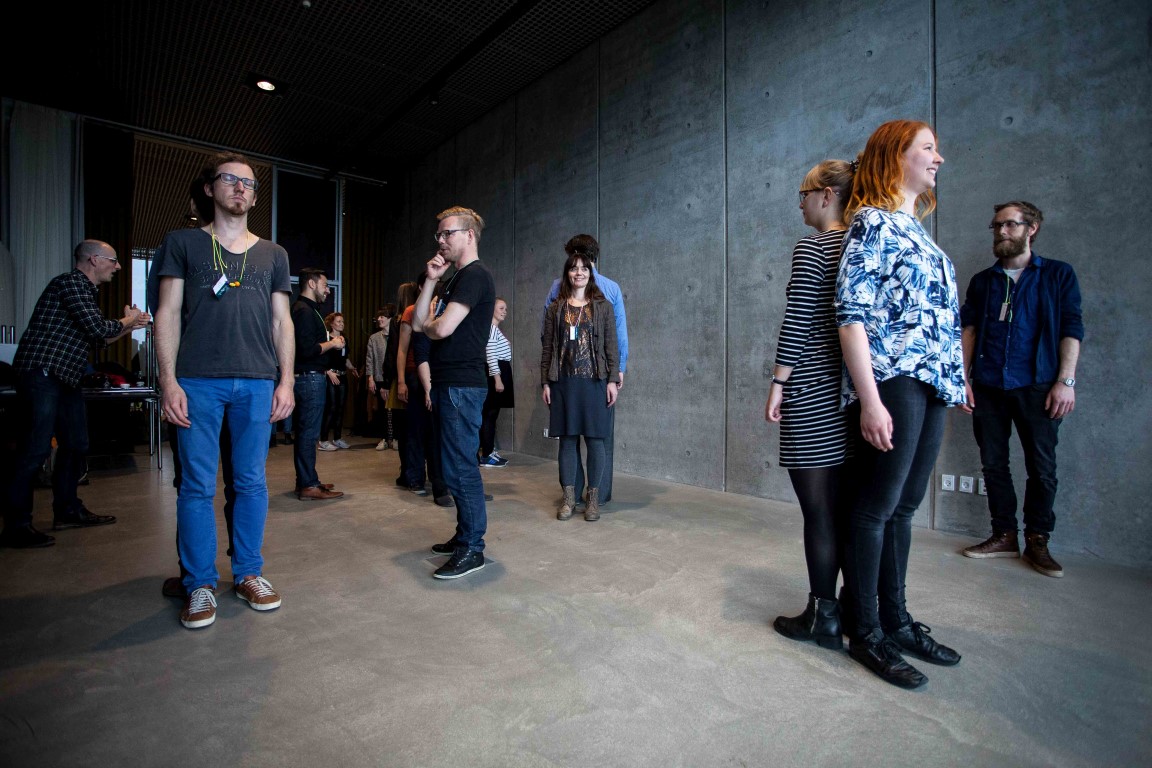[et_pb_section admin_label=”section”][et_pb_row admin_label=”row”][et_pb_column type=”4_4″][et_pb_text admin_label=”Text” background_layout=”light” text_orientation=”left” use_border_color=”off” border_color=”#ffffff” border_style=”solid”]
Counterplay was a brilliant experience for me in so many ways, and made a big difference to how I approach things both as an artist and a teacher. I’m going to focus in a series of 3 short blogs on some ways it has affected my teaching and inspired me to share these ideas with others at my university.
The biggest thing that Counterplay did for me was probably to give me the faith to do some of the things I had already wanted to do but hadn’t because I somehow felt like they weren’t productive or useful enough. But then I realised that play can do 3 key things that can bring students to a place where they are ready to learn:
- Play can help people bond with each other; to relax in each other’s company
- Play can energise and awaken people
- Play can focus people
Obviously there are loads of other things that play can do, and Bernie de Koven has written eloquently about many of them. And of course, play, like art, doesn’t need to have any purpose beyond itself. But these are the things I’m going to focus on in these blog posts, starting with relaxation and bonding.
Relaxation and Bonding
 When my students arrive in the first semester of their first year, they are terrified. Terrified because they are away from home, terrified of university, terrified of us the teachers and most of all terrified of how they will be judged by their fellow students, the impression that they will make on each other, whether anyone will want to be their friend, whether anyone will fancy them. In this state of fear it is difficult for them to learn anything. Play can go a long way towards banishing this fear by breaking down barriers, helping people laugh together, learn about each other, complete a shared goal together or just be silly and overcome social awkwardness. Its not only at the start of the first year that students need to bond. At the start of every new semester they are in new groups, sometimes with people they’ve never worked with. And sometimes during a semester itself the pressures of group work can start to rupture a group. Although the causes of these ruptures need to be addressed in themselves, play can help complete this healing process.
When my students arrive in the first semester of their first year, they are terrified. Terrified because they are away from home, terrified of university, terrified of us the teachers and most of all terrified of how they will be judged by their fellow students, the impression that they will make on each other, whether anyone will want to be their friend, whether anyone will fancy them. In this state of fear it is difficult for them to learn anything. Play can go a long way towards banishing this fear by breaking down barriers, helping people laugh together, learn about each other, complete a shared goal together or just be silly and overcome social awkwardness. Its not only at the start of the first year that students need to bond. At the start of every new semester they are in new groups, sometimes with people they’ve never worked with. And sometimes during a semester itself the pressures of group work can start to rupture a group. Although the causes of these ruptures need to be addressed in themselves, play can help complete this healing process.
Play to Bond
The Map Exercise
This is my favourite bonding activity and I learned it from the theatre director Ian Rickson. By the end of it I (and the rest of the group) know everyone’s names, have an insight into who they are and everyone feels closer together. You can feel the atmosphere change as the activity progresses. Start by establishing that the room represents a map of the world and indicate which direction north, south, east and west are. I always say that the UK (or whichever country I’m in) is enlarged so it doesn’t get too cramped! The activity has 4 phases:
Go to the place in the world where you were born. Then everyone in turn (you can work north to south, east to west or whatever) says their name, the place where they were born and 1 thing about their name: either what it means, why it was given to them or how they feel about it.
Go to the place in the world where you were when you were 5 years old. Then everyone it turn says their name again, where they are now and either their first memory or an early memory.
Go to the place in the world where you were when you were 15 years old. Then everyone in turn (you can work in a different direction each time) says their name, where they are now and briefly shares what it was like being 15 and what they wanted or what their biggest ambition was at this time.
Go to the place where you slept last night (at this point normally everyone comes closer together). Everyone in turn says their name, where they are and briefly how they feel about this place.
[/et_pb_text][et_pb_image admin_label=”Image” src=”http://www.counterplay.org/wp-content/uploads/2016/08/IMG_2192-Medium.jpg” show_in_lightbox=”off” url_new_window=”off” use_overlay=”off” animation=”left” sticky=”off” align=”left” force_fullwidth=”off” always_center_on_mobile=”on” use_border_color=”off” border_color=”#ffffff” border_style=”solid”] [/et_pb_image][et_pb_text admin_label=”Text” background_layout=”light” text_orientation=”left” use_border_color=”off” border_color=”#ffffff” border_style=”solid”]
Two Truths One Lie
This game is quite well known. I like to do it if I don’t have time to do the map exercise or perhaps at the start of semester 2 when I have a new class. In a circle everyone says their name and two things about themselves that are true and one thing that is a lie. You can play it in different ways – either everyone can guess immediately after the person has spoken which was the lie or, at the end of the circle people can mingle and guess about each other, depending on the sort of dynamics you want to create. There is a variation where you can play it twice, inviting people to try and give a different impression of themselves than they gave before – I find this useful with students as they are often trying to project something about themselves and it can be good to suggest they show a different side to themselves.
Name Tag
I sometimes play this after one of the above as it gets people to make active use of the names they have learned. It can help to play a short game of normal tag as a warm up. In name tag, the person who is being chased by IT can call out the name of someone else in the group, who immediately then becomes IT. It can get quite chaotic but is fun and definitely makes you try to remember the names of all the people around you.
Hug Tag
Hug Tag works like normal tag except from that you can escape IT by hugging someone else. Additional rules are that you can’t hug someone for more than 5 seconds, you can’t hug the same person twice in a row and IT can’t hang around a hugging pair waiting for 5 seconds to be up.
[/et_pb_text][et_pb_post_nav admin_label=”Post Navigation” in_same_term=”off” hide_prev=”on” hide_next=”off” next_text=”Three Things that Play can do in a University (or indeed anywhere) Part 2: Energising and Awakening” use_border_color=”off” border_color=”#ffffff” border_style=”solid” /][/et_pb_column][/et_pb_row][/et_pb_section]

Leave a Reply